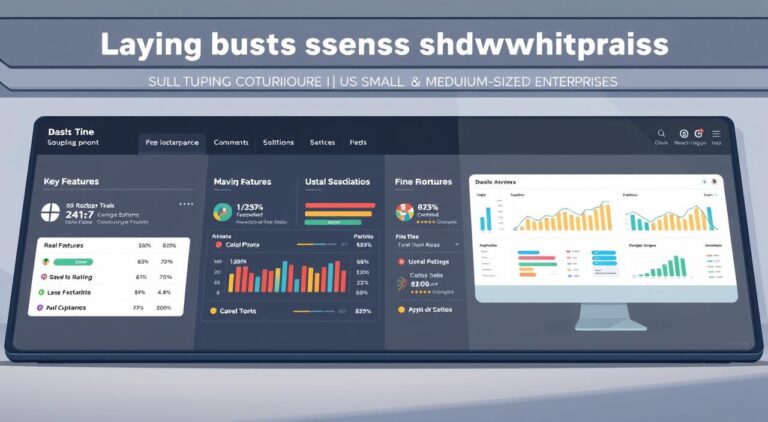Top Productivity Automation Tools for American Companies
Quick answer: The best stack for U.S. teams blends AI chatbots, workflow connections, and content platforms to speed up work across sales, marketing, support, and operations.
This guide ranks solutions by ROI, integration breadth, and time-to-value, citing trusted vendors like OpenAI, Anthropic, Google, and Zapier to support real decisions.
We show practical ways to deploy systems for intake, approvals, content creation, summaries, and reporting. You’ll get examples of platform choices and deployment steps that move a pilot into scale.
What to expect: side-by-side comparisons, pricing per month ranges, risk notes on data privacy and model grounding, and tactical next steps to align stakeholders and ownership.
Key Takeaways
- Combine chat, workflow, and content platforms to accelerate work across teams.
- Evaluate options by ROI, integrations, and speed to value.
- Use trusted vendors like OpenAI, Anthropic, Google, and Zapier as anchors.
- Focus pilots on intake, approvals, content, and reporting to scale fast.
- Assess governance, privacy, and model grounding before wide rollout.
Quick answer: The best automation stack for U.S. teams right now
Quick answer: blend AI chat, visual workflow builders, and brand-safe content platforms to cut manual steps and deliver measurable ROI in weeks.
Core picks by use case:
- Chat: ChatGPT (OpenAI), Claude 3.5 Sonnet — fast contextual replies and app hooks.
- Workflow: Make, Cflow — visual builders with broad connectors to link apps and triggers.
- Content: Jasper, Writer — on-brand generation and editing features.
- Meetings: Otter — reliable transcription across Zoom, Meet, and Teams.
- Scheduling: Motion — auto-scheduling to free calendar time.
- Search: Perplexity — sourced answers with citation links.
Why these picks win on ROI, integration, and time-to-value
ROI drivers: out-of-the-box features, ready templates, and broad connectors reduce manual work and speed results.
Integration advantage: platforms like Make and Zapier link CRMs, forms, and docs so a lead can be captured, enriched, routed to CRM, and followed up automatically — a clear example of saved hours per week.
“Choose vendors with enterprise controls and audit trails to protect data while you scale.”
Get started: pick one north-star workflow, run a 90-day pilot in marketing or support, track KPIs, and expand when the team shows clear lift.
How we selected the top productivity automation tools for American companies
Selection prioritized solutions that deliver clear ROI and minimal deployment friction. Our review combined hands-on trials with public vendor documentation to score practical value.
Evaluation criteria focused on user experience, core features, monthly pricing transparency, breadth of integration, and verified reviews.
- We scored UX quality, depth of features, and integration breadth against real use cases.
- Field tests measured setup friction, admin controls, SSO, and governance needs for U.S. teams.
- Data inputs included Zapier app reviews, Google AI guides, Anthropic and OpenAI product notes, and Perplexity results.
We also checked scalability, security attestations (SOC2/ISO), and vendor roadmaps. Reviews from real people and teams adjusted weights for reliability and support response time.
“Choose vendors that make data handling, roles, and retention clear before wide adoption.”
AI chatbots that supercharge workflows
Modern conversational AI can route requests, extract data, and trigger actions across apps. These chat-based assistants speed up routine work and keep teams aligned without heavy engineering.
Key platform strengths:
- ChatGPT (OpenAI): GPT-4o/4o-mini and o1 reasoning models handle file analysis and summarization. Strong Zapier integration lets it draft emails, update docs, and push reports automatically.
- Claude (Anthropic): Claude 3.5 Sonnet offers fast reasoning and an April 2024 knowledge cutoff. Artifacts let teams preview and refine outputs like code snippets or formatted content in-panel.
- Meta AI: U.S. availability, social context signals, and image/animation generation help creative workflows and rapid content ideation.
- Zapier Agents: No-code agents read data across CRMs, sheets, and ticketing apps, transform records, and run unattended actions with audit trails.
Use cases are clear: auto-collect survey responses, summarize themes with ChatGPT, generate follow-up emails, and distribute results to a team list with logs.
Combine chatbots with document parsers to extract fields from PDFs and feed systems of record. Define prompts, guardrails, and reference sources so outputs stay on-brand and accurate.
Operational notes: look for persistent memory, robust file handling, and retrieval features to ground responses in internal data. Configure role-based access and data policies to meet compliance needs.
AI search and research assistants for faster, sourced answers
AI search assistants speed research by delivering cited answers and concise summaries you can trust.
Perplexity produces high-quality answers with citations and follow-ups that stay on topic. It blends Google, Bing, and proprietary ranking signals so teams can verify information quickly. Perplexity’s Zapier integration captures snippets and routes them into Slack, email, or docs to keep research moving.
Google AI Overviews give a synthesized snapshot as a fast starting point before deep dives. Arc Search’s “Browse for me” compiles structured results on iOS/iPadOS, making it easier to scan and compare sources on mobile.
“Use search to outline content, collect references, then hand off drafts for human review.”
- Practical tip: configure prompts to request citations, quotes, and key stats.
- Validate links to avoid hallucinations and save curated research in shared repositories.
- Example: monitor trends, auto-generate an executive brief, and email stakeholders before standup.
Track time saved and data quality to quantify impact across marketing, product, and strategy. Use these apps and features to speed discovery while keeping accuracy front and center.
Workflow and business process automation platforms
Visual workflow builders make it fast to map and standardize repeatable business processes.
Why it matters: visual designers, broad integrations, and scalability let operations replace manual work with auditable flows. Start small, prove ROI, then expand.
Make
Make offers a drag-and-drop visual builder with “scenarios,” instant webhooks, advanced filters, and 2,000+ app integrations. The platform supports branching logic and real-time tests. Pricing starts at $9/month for 10,000 operations with a free tier. Key features speed orchestration across CRM, docs, and chat.
Flowlu, Cflow, and ProcessMaker
Flowlu blends CRM, project tracking, and finance with workflow automation and templates. Cflow adds a drag-and-drop designer, task assignment, alerts, and monitoring with ~1,000 integrations. ProcessMaker targets enterprise needs with forms, doc management, reporting, and a Platform plan from $1,475/month.
Kissflow and Bonitasoft
Kissflow enables rapid approvals, form building, case management, and analytics with no-code connectors. Bonitasoft is an open-source BPM that scales with workflow, analytics, and enterprise deployment options.
- ROI drivers: visual builders, ready connectors, and reusable flows cut manual hours quickly.
- Confirm role-based permissions, audit logs, sandboxes, and rollback before production.
- Example: auto-provision onboarding—capture intake, create tasks, set SLAs, notify owners, and log progress.
“Pick platforms with versioning and test environments to reduce rollout risk.”
Project and task management tools with automation built in
A reliable management stack moves tasks from inbox to calendar with minimal friction. Use calendar-first systems to protect focus and keep work visible across the team.
Motion: auto-scheduling that respects priorities
Motion auto-places tasks on your calendar based on priority, deadlines, and availability.
It integrates with personal and work calendars and gives capacity views so managers balance load without micromanaging.
Asana and Any.do: rules, templates, and cross-team orchestration
Asana and Any.do use rules and templates to cut manual updates and status chasing.
They support cross-project automations that keep projects aligned and reduce repeat work.
Ways to keep track of important tasks every day
- Auto-place tasks on the calendar to protect focused time and meet deadlines.
- Build recurring workflows for standups, sprints, and approvals so owners get timely context.
- Create SLA views that surface blockers and overdue deliverables immediately.
- Keep track of important tasks in smart lists tied to project priorities.
- Convert inbound emails into tasks with owners and due dates to avoid missed requests.
“Calendar-based scheduling ensures the right work lands at the right moment.”
Content creation and marketing automation platforms
Content platforms now combine generation, review, and publishing into one governed workflow. This reduces handoffs and helps teams move from brief to publish with clear audit trails.
Jasper and Writer
Jasper and Writer: brand-safe AI for ads, blogs, and campaigns
Jasper accelerates campaign copy, product pages, and ad variations with templates and internet-connected research. It also supports image generation and Zapier integration to push drafts into CMS or review queues.
Writer emphasizes brand governance and accuracy. Its proprietary models and style controls suit regulated business environments and large teams. Connect via Zapier to route drafts into legal review.
Typeface and Narrato
Typeface and Narrato: end-to-end creative ops with on-brand automation
Typeface combines a brand-safe copilot, image studio, and enterprise governance to orchestrate full campaigns with consistent visuals and tone.
Narrato streamlines ops from brief to publish with 100+ AI templates, an SEO brief generator, editorial calendar, automated workflows, and CMS/social publishing. Pro and Business tiers match higher output needs.
- Outcome: auto-generate ad variants, send for legal review, then publish approved assets with analytics tracking.
- Checklist: confirm custom style rules, content ownership, and audit trails before rollout.
- Process tip: evaluate templates for emails, landing pages, and blogs and integrate with project boards to automate reviews and deadlines.
“Align plan tiers to expected seats and output volume to control costs while scaling.”
Text enhancement and quality control
Polished copy and consistent voice turn scattered drafts into reliable assets across teams. Use a single editorial layer to catch errors early and speed approvals.
Grammarly standardizes tone, clarity, and structure with browser extensions and editor plugins that meet users where they write every day. It adds basic generative features and enforces style rules across documents.
Wordtune
Wordtune delivers granular rewrites, synonyms, and sentence-level edits to sharpen phrasing. It’s ideal when you need multiple alternate lines quickly.
ProWritingAid
ProWritingAid supplies deep analytics on grammar and style plus lifetime plan options. Editors get reports that help refine long-form documents at scale.
- Primary capabilities: tone checks, rewrites, style stats, and domain dictionaries.
- Enforce editorial checklists to cut back-and-forth in reviews.
- Integrate with CMS and document workflows so quality gates run before publish.
“Train teams on when to accept suggestions to preserve brand voice and accuracy.”

Video generation and editing that saves hours
Short-form video workflows now shave hours from post-production by automating cuts, captions, and AI b-roll. This reduces review rounds and speeds delivery of campaign assets.
Runway, Descript, and Filmora each target a clear step in the process: generation, transcript editing, and cleanup. Choose the mix that matches your security needs and output volume.
Runway: Gen-3 Alpha and enterprise integrations
Runway’s Gen-3 Alpha enables AI video generation, frame inpainting, and model training on custom footage. Zapier hooks let teams orchestrate renders into project boards and review queues.
Descript and Filmora: text-based editing and AI clean-up
Descript turns transcripts into editable timelines and auto-trims filler words to speed talking-head edits.
Filmora offers AI background removal, denoise, and audio repair so non-specialists can finish clean cuts fast.
- Example: convert a webinar into short clips, auto-caption in Descript, add AI b-roll in Runway, and schedule publishing.
- Estimate saved time on manual edits to prioritize highest-ROI content types and plan monthly render budgets.
- Confirm enterprise security, storage limits, and brand safeguards before enabling model training on internal footage.
“Standardize naming, versions, and approvals so repeatable video tasks run on rails.”
Image generation for campaigns and documents
High-fidelity image apps now give creative teams control and speed. Use them to turn briefs into ad-ready visuals with fewer review cycles.
Midjourney: high-fidelity images and prompt control
Midjourney excels at rich, stylized outputs and precise prompt tuning via browser or Discord. Art directors and marketers iterate hero concepts fast and keep brand direction clear.
Ideogram: accurate text-in-image for ads and social
Ideogram shines where typography matters. Its accurate text rendering makes banners, ad units, and social tiles production-ready with fewer fixes.
- Midjourney helps teams spin up on-brand visuals and iterate quickly with exact prompts.
- Ideogram’s text-in-image strength reduces manual layout work for ad creatives.
- Example: generate multiple hero concepts, validate with stakeholders, then finalize variants.
- Manage licensing and usage policies so brand assets remain protected.
- Create a prompt library and visual standards to keep content consistent.
- Evaluate plan tiers for render speeds, privacy modes, and images per month.
- Use new features to expand use cases from mockups to editorial art.
- Pair image generation with content calendars to meet campaign deadlines.
- Track creative cycle times to show efficiency gains in design orgs.
- Keep a feedback loop between creatives and performance teams to refine prompts over time.
“Prioritize render speed, privacy options, and clear licensing when selecting an image generation plan.”
Social media management with automation
Scheduling, repurposing, and analytics form the backbone of a scalable social strategy. Use platforms that centralize calendars and let your team coordinate posts across channels.
Vista Social and Buffer: cross-channel scheduling and AI repurposing
Vista Social centralizes planning and scheduling so your team coordinates campaigns across networks efficiently. Its AI repurposing and Zapier integration help move content into CRM, dashboards, or review queues.
Buffer offers AI-assisted copy that tailors tone and length per channel and an ideation scratchpad to speed creative work.
FeedHive: content recycling to extend reach
FeedHive recycles high-performing posts to save time and keep cadence steady. This reduces creation load while maintaining reach and engagement.
- Example: convert a blog into a week of posts, auto-schedule at best times, and log engagement data to dashboards.
- Build approval flows with role permissions so message quality stays high as volume scales.
- Use analytics to spot themes that improve conversion and to set UTM standards for clear attribution.
“Train users on repurposing frameworks to accelerate creation while protecting brand voice.”
Voice and music generation for content teams
AI-driven voice and music let teams produce narration and tracks at scale without long studio bookings.
Why it matters: modern audio apps speed creative cycles, reduce outsourcing cost, and let non-specialists ship polished assets quickly.
ElevenLabs: premium-quality narration and SFX at scale
ElevenLabs offers 300+ natural voices and built-in SFX to create production-ready narration for videos, explainers, and training.
Scale & integrations: Zapier can send approved scripts to ElevenLabs, generate narration, and store outputs automatically in your media library.
Suno and AIVA: rapid audio creation for campaigns
Suno turns text prompts into full songs with lyrics and vocals, ideal for quick campaign hooks or social clips.
AIVA supports structured composition from styles or chord progressions and includes timeline editing for fine control.

- ElevenLabs delivers production-ready narration for videos, explainers, and training with natural voices and SFX.
- Suno creates quick, catchy tracks from prompts for campaign hooks or social assets.
- AIVA supports structured composition from styles or chord progressions, with editing for fine control.
- Example: send approved scripts from Docs to ElevenLabs, generate narration, then upload to your media library automatically.
- Standardize licensing workflows so teams know where and how audio can be used.
- Evaluate plan limits by characters, renders per month, and distribution rights before launch.
- Train editors on audio cleanup and mixing basics to integrate AI assets smoothly.
- Document pronunciation dictionaries and brand voice settings for consistency.
- Use tools help playbooks so non-audio specialists can contribute to content production.
- Track time saved in voiceover and music sourcing to quantify productivity gains.
“Standardize licensing and plan limits up front to avoid rework and protect distribution rights.”
Knowledge management and AI grounding
Centralized knowledge platforms let teams pull verified answers from linked repositories in seconds.
Mem and Notion AI: connect documents, data, and team context in one place
Mem auto-tags notes and offers AI search over personal knowledge. It links via Zapier so emails, meeting notes, and tasks flow into a searchable index.
Notion AI reads connected databases and tools (Slack, Google Drive) to summarize, draft, and answer company questions from current records.
- Connect Mem or Notion AI to core repositories so teams can query documents and data in one place.
- Use grounding to constrain AI outputs to approved sources and reduce factual drift.
- Build a workflow that syncs emails, meeting notes, and project docs into searchable spaces automatically.
- Assign process owners to maintain versioning, data freshness, and lifecycle rules.
- Train the team on prompts and reference linking to boost retrieval and daily work accuracy.
- Quick ops: review usage each month, prune stale content, and prioritize high-value knowledge hubs.
- Security: define integration scopes to protect sensitive information while enabling useful cross-tool context.
- Outcome: faster answers, fewer duplicates, and clearer accountability across the business.
“Grounded search reduces risky outputs by tying answers to approved sources.”
Security, compliance, and data governance considerations
A practical security plan begins by labeling data, assigning roles, and mapping each tool integration. Start with a clear inventory of business data and documents so every owner knows what is sensitive and what is not.
Data privacy, access controls, and brand governance
- Define data classes and map which users may access each class.
- Require SSO, role-based access, and separate test and production environments.
- Make sure vendors document retention, deletion, and encryption in transit and at rest.
- Establish prompt and template review with brand checkpoints before broad rollout.
- Validate SOC2/ISO claims and ask for admin reporting, export options, and content ownership terms.
- Review training data policies, model update cadence, and opt-out paths for sensitive documents.
- Confirm integration scopes so only intended systems and fields are accessible.
- Document incident response and run month-over-month risk reviews with security stakeholders.
“Standardize a way to evaluate ethical AI posture, bias mitigation, and explainability where required.”
Operational checklist
- Train people regularly on safe handling and acceptable use of AI features.
- Assign owners to maintain retention rules and to audit access logs.
- Use this process to keep legal, finance, and healthcare teams confident while you scale integrations.
Integration strategy: build a connected automation ecosystem
Focus first on how systems speak to one another. Map data paths, events, and ownership before you add connectors. This upfront clarity prevents duplicate records and fragile handoffs.
Zapier, native connectors, and APIs for smooth workflows
Standardize on Zapier and native connectors to cut custom code and reduce maintenance. Zapier links thousands of apps and lets AI chatbots, search, and content platforms trigger actions without engineering cycles.
Reserve APIs for high-value needs that require performance or custom data mappings. Use Make where instant webhooks and branching logic speed complex orchestration.
Calendars, email, CRM, documents, and analytics in one platform
Unify calendar, emails, CRM, docs, and analytics so a single event can advance work end-to-end. Map the ways data moves, then define triggers and actions that create tasks automatically.
- Build reusable components: shared auth, field mappings, and error handlers to speed delivery.
- Auto-create tasks from forms and inboxes so nothing slips through the cracks.
- Track metrics tied to cycle time, SLA attainment, and error rates each month.
- Pilot with one department, then replicate proven integration patterns across the business.
- Maintain a runbook and review integration health monthly to resolve incidents fast.
“Prioritize interoperability and clear ownership so integrations scale with the team.”
Pricing, plans, and how to get started without risk
Start small: a low-cost plan can prove ROI without long-term risk. Begin on a free plan or trial to validate fit. Then upgrade when you need higher limits, governance, or APIs.
Free plan vs. paid plan: when to upgrade
Use a free plan to run a short pilot. Test core flows, integrations, and customer support response.
Upgrade when: you hit limits on runs, storage, or users. Or when you need admin controls and audit logs.
Estimating monthly cost by team size and usage
Estimate cost per month by counting licensed users, expected runs or renders, and storage needs.
- Example: ChatGPT Plus or Claude Pro starts near $20/month per seat; Make begins at $9/month; ProcessMaker Platform can run $1,475/month for enterprise needs.
- Model roles—creators, reviewers, and admins—to avoid over-licensing.
- Ask vendors about annual discounts, nonprofit or startup pricing, and SLA terms that match your hours.
“Pilot small, measure time saved on tasks like drafting and scheduling, then scale with confidence.”
Quick checklist to de-risk purchase:
- Start on a free plan and run a 30-day pilot with one team.
- Track time saved, error rates, and adoption every day.
- Prioritize tiers that unlock API and integration features your apps need.
- Document onboarding steps so get started is fast for new users.
Conclusion
End by unifying drafting, handoffs, and scheduling so your team spends more time on impact. Start with one or two workflows that draft content, route approvals, and place tasks on the calendar.
Quick next steps: pick a pilot, use a free plan to validate limits, and map ownership of documents and data.
Build a simple process playbook that shows how information moves and who approves each task. Use integrations to keep emails, content, and files in one place with clear permissions.
Measure gains with cycle time, error rates, on-time delivery, and project completion. Keep leaders informed via dashboards so budget and monthly plan upgrades match adoption.
Make sure governance, access controls, and audit trails are in place before widening sensitive use cases. Standardize calendar and workflow habits so approvals and handoffs happen reliably.






